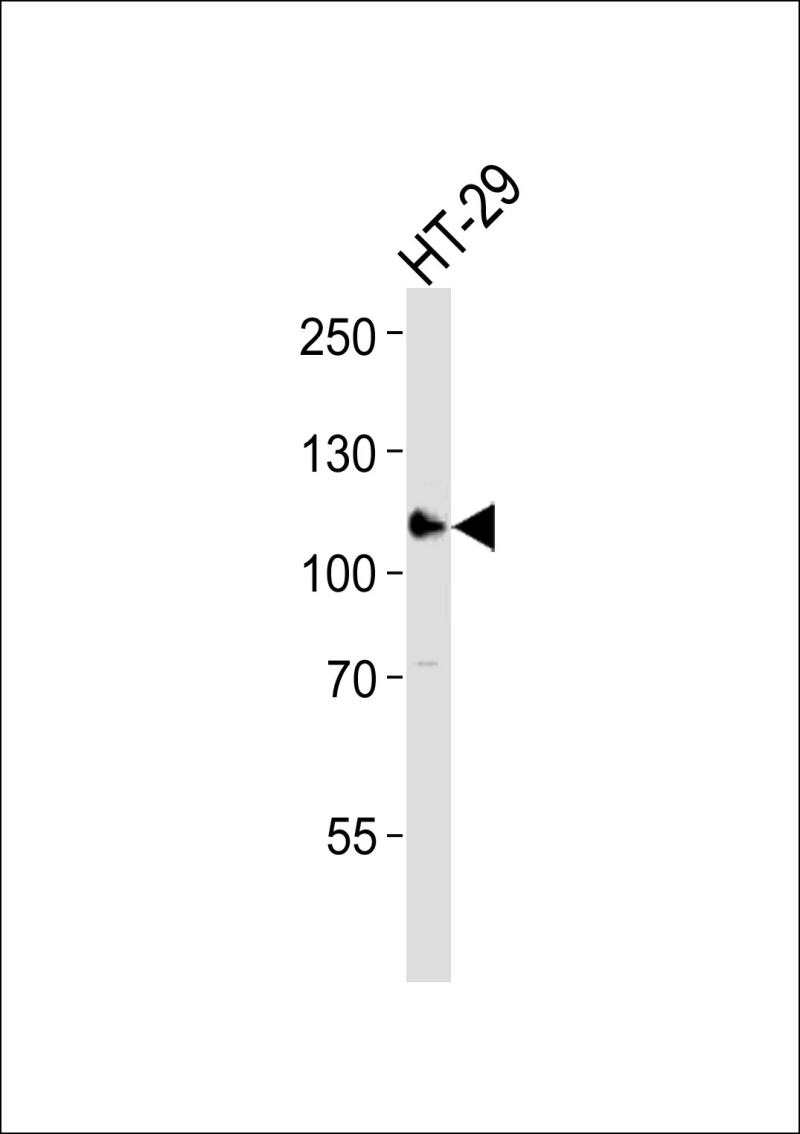

| WB | 1/1000 | Human,Mouse,Rat |
| IF | 咨询技术 | Human,Mouse,Rat |
| IHC | 咨询技术 | Human,Mouse,Rat |
| ICC | 技术咨询 | Human,Mouse,Rat |
| FCM | 咨询技术 | Human,Mouse,Rat |
| Elisa | 咨询技术 | Human,Mouse,Rat |
| Aliases | Serine/threonine-protein kinase/endoribonuclease IRE2, Endoplasmic reticulum-to-nucleus signaling 2, Inositol-requiring protein 2, hIRE2p, Ire1-beta, IRE1b, Serine/threonine-protein kinase, Endoribonuclease |
| Entrez GeneID | 10595 |
| WB Predicted band size | 102.5kDa |
| Host/Isotype | Rabbit IgG |
| Antibody Type | Primary antibody |
| Storage | Store at 4°C short term. Aliquot and store at -20°C long term. Avoid freeze/thaw cycles. |
| Species Reactivity | Human |
| Immunogen | This ERN2 antibody is generated from rabbits immunized with a KLH conjugated synthetic peptide between 39-72 amino acids from the N-terminal region of human ERN2. |
| Formulation | Purified antibody in PBS with 0.05% sodium azide,1%BSA and 50% glycerol.prepared by Saturated Ammonium Sulfate (SAS) . |
+ +
以下是3篇关于ERN2(N-term)抗体的参考文献,包含文献名称、作者及摘要内容概括:
---
1. **文献名称**: *"IRE1β Negatively Regulates Intestinal Antimicrobial Responses and Mitochondrial Homeostasis in Colitis"*
**作者**: Lee AH, et al.
**摘要**: 本研究揭示了内质网应激传感器IRE1β(即ERN2)在肠道炎症中的调控作用。作者通过使用ERN2的N端特异性抗体,证实其在结肠上皮细胞中通过调控抗菌肽表达和线粒体功能,缓解炎症性肠病的病理进程。
---
2. **文献名称**: *"Activation of the Unfolded Protein Response by Mutant Profilin 1 Expressed in ALS"*
**作者**: Kim HJ, et al.
**摘要**: 该研究探讨了肌萎缩侧索硬化症(ALS)中突变蛋白profilin 1对未折叠蛋白反应(UPR)的激活机制。利用ERN2(N-term)抗体进行免疫印迹分析,发现IRE1β通路在疾病模型中特异性激活,提示其与神经元退行性病变的关联。
---
3. **文献名称**: *"Endoplasmic Reticulum Stress Signaling: The Core Pathway of the Unfolded Protein Response"*
**作者**: Hetz C, et al.
**摘要**: 综述了内质网应激信号通路的关键分子机制,重点比较了IRE1α和IRE1β(ERN2)的功能差异。文中提及ERN2的N端抗体在区分两种异构体中的重要性,并强调其在肠道和免疫细胞特异性应激响应研究中的应用价值。
---
**备注**:若需具体文献链接或补充信息,可进一步提供DOI或PMID编号。
The ERN2 (N-term) antibody is designed to target the N-terminal region of ERN2 (Endoplasmic Reticulum to Nucleus Signaling 2), also known as IRE1β (Inositol-Requiring Enzyme 1β), a key sensor of endoplasmic reticulum (ER) stress. ERN2 is a transmembrane protein in the ER that belongs to the conserved IRE1 family, alongside IRE1α (ERN1). While IRE1α is ubiquitously expressed, IRE2β is predominantly found in epithelial cells of the gastrointestinal tract and plays a specialized role in managing ER stress in secretory cells.
The N-terminal domain of ERN2 resides in the ER lumen and detects the accumulation of misfolded proteins during ER stress. Upon activation, ERN2 initiates the unfolded protein response (UPR) through its C-terminal cytoplasmic kinase and endoribonuclease domains, splicing XBP1 mRNA to produce the transcription factor XBP1s, which regulates genes involved in protein folding, degradation, and inflammation.
ERN2 (N-term) antibodies are commonly used in research to study ER stress pathways, inflammatory bowel diseases (e.g., Crohn’s disease), and intestinal homeostasis. These antibodies help detect ERN2 expression, cleavage products, or isoforms in techniques like Western blotting, immunofluorescence, or immunohistochemistry. They are often raised in rabbits or mice and validated for specificity in human or murine samples. Studies using this antibody have contributed to understanding ERN2's role in mucosal immunity, epithelial barrier function, and its potential link to intestinal disorders or cancers.
×